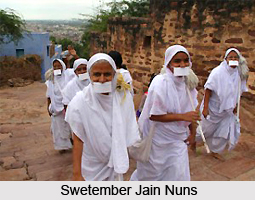 In the early decades of the twentieth century few prominent movements of a socio-religious nature took place among the Swetambara Sect. The `Bala-diksha Pratibandha Andolana` i.e. the `Prevention of Initiation of Children Movement` was initiated by important intellectuals and social workers amongst the Murtipujaka Swetambara Jains.
In the early decades of the twentieth century few prominent movements of a socio-religious nature took place among the Swetambara Sect. The `Bala-diksha Pratibandha Andolana` i.e. the `Prevention of Initiation of Children Movement` was initiated by important intellectuals and social workers amongst the Murtipujaka Swetambara Jains.
The movement was started to protest against the prevailing large- scale practice of initiating adolescents and young children sometimes who are even below 10 years to the ascetic order of the sect. It was felt that small children are not at all in a position to take an independent decision regarding the adoption of the ascetic career as a goal in their life.
The movement was carried on for a long time. Due to prolonged controversies, the opinion of the general public went in favour of putting a ban on such practise of initiation of children into ascetic life. It also favoured of prescribing an age limit for entry into the ascetic order. However, in spite of forceful propaganda and general awakening, the movement of `Bala-diksha Pratibandha Andolana` could achieve much success in discontinuing the practice, but the actual frequency of such initiations became much less. The youth amongst the Swetambara Jains took a lead in the initiation of the movement. They also founded a new organization by the name Jain Yuvak Sangh for carrying out this and other social reforms amongst Jains. Due to this agitation the old princely State of Baroda passed legislation prohibiting initiation of children in the state.
Another movement by the name `Ek Acharya Andolan`, i.e. the `One Religious Head Movement` was started by the Sthanakvasi Swetambara Jains. The movement was initiated by the intellectuals and social workers to establish the power with power of one acharya (pontiff) on the entire ascetic order of the Sthanakvasi denomination.
The `Ek Acharya Andolan` was quite successful and the system of supremacy of one acharya was recognised and accepted by the Sthanakvasi Jains. With the initiation of the movement all the monks of the Sthanakvasi section from all over India were brought under the direct control of one acharya. This helped in restoring the much needed unity amongst the laity of the Sthanakvasi section also.



















